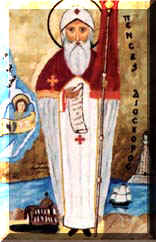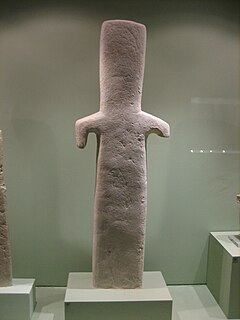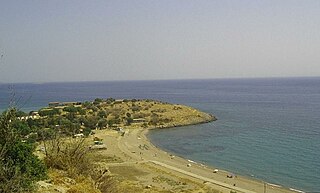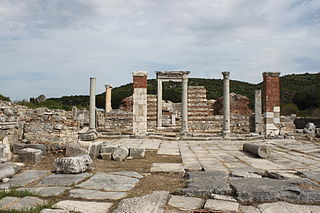
Ephesus was an ancient Greek city on the coast of Ionia, three kilometres southwest of present-day Selçuk in İzmir Province, Turkey. It was built in the 10th century BC on the site of the former Arzawan capital by Attic and Ionian Greek colonists. During the Classical Greek era it was one of the twelve cities of the Ionian League. The city flourished after it came under the control of the Roman Republic in 129 BC.
Monophysitism is the Christological position that, after the union of the divine and the human in the historical incarnation, Jesus Christ, as the incarnation of the eternal Son or Word (Logos) of God, had only a single "nature" which was either divine or a synthesis of divine and human. Monophysitism is contrasted to dyophysitism which maintains that Christ maintained two natures, one divine and one human, after the incarnation.

Nestorius was Archbishop of Constantinople from 10 April 428 to August 431, when Emperor Theodosius II confirmed his condemnation by the Council of Ephesus on 22 June.
Eutyches was a presbyter and archimandrite at Constantinople. He first came to notice in 431 at the First Council of Ephesus, for his vehement opposition to the teachings of Nestorius; his condemnation of Nestorianism as heresy led him to an equally extreme, although opposite view, which precipitated his being denounced as a heretic himself.

Pope Dioscorus I of Alexandria, 25th Pope of Alexandria & Patriarch of the See of St. Mark. He was deposed by the Council of Chalcedon in 451 but was recognized as Patriarch by the Coptic Church until his death. He died on the Island of Gangra, Paphlagonia, in September 454. He is venerated as a saint by the Coptic and other Oriental Orthodox churches.

Nysa on the Maeander was an ancient city and bishopric of Asia Minor, whose remains are in the Sultanhisar district of Aydın Province of Turkey, 50 kilometres (31 mi) east of the Ionian city of Ephesus, and which remains a Latin Catholic titular see.

Nicene Christianity as a set of Christian doctrinal traditions upholds the Nicene Creed, traditionally formulated at the First Council of Nicaea in AD 325 and amended at the First Council of Constantinople in AD 381. Nicene Christianity can equate to mainstream Christianity.

A xoanon was an Archaic wooden cult image of Ancient Greece. Classical Greeks associated such cult objects, whether aniconic or effigy, with the legendary Daedalus. Many such cult images were preserved into historical times, though none are known to have survived to the modern day, except where their image was copied in stone or marble. In the 2nd century CE, Pausanias described numerous xoana in his Description of Greece, notably the image of Hera in her temple at Samos. "The statue of the Samian Hera, as Aethilos [sic] says, was a wooden beam at first, but afterwards, when Prokles was ruler, it was humanized in form". In Pausanias' travels he never mentions seeing a xoanon of a mortal man.

Theodotion was a Hellenistic Jewish scholar, perhaps working in Ephesus, who in c. 150 CE translated the Hebrew Bible into Greek. Whether he was revising the Septuagint, or was working from Hebrew manuscripts that represented a parallel tradition that has not survived, is debated. In the 2nd century Theodotion's text was quoted in The Shepherd of Hermas and in Justin Martyr's Dialogue with Trypho.
His finished version, which filled some lacunae in the Septuagint version of the Book of Jeremiah and Book of Job, formed one column in Origen of Alexandria's Hexapla, c. 240 CE. The Hexapla, now only extant in fragments, presented six Hebrew and Greek texts side-by-side: two Greek versions, by Aquila and Symmachus, and Theodotion's version following it, apparently reflecting a contemporary understanding of their historical sequence.

Lebedus or Lebedos was one of the twelve cities of the Ionian League, located south of Smyrna, Klazomenai and neighboring Teos and before Ephesus, which is further south. It was on the coast, ninety stadia (16.65 km) to the east of Cape Myonnesus, and 120 (22.2 km) west of Colophon.

The Church of Mary is an ancient Christian cathedral dedicated to the Theotokos, located in Ephesus. It is also known as the Church of the Councils because two councils of importance to the history of Early Christianity are assumed to have been held within. The church is located in the south stoa of the Olympieion next to the harbor of Ephesus.
Sosipatra of Ephesus was a Neoplatonist philosopher and mystic who lived in the first half of the 4th century CE. The story of her life is told in Eunapius' Lives of the Sophists.
Caloe was a town in the Roman province of Asia. It is mentioned as Kaloe or Keloue in 3rd-century inscriptions, as Kalose in Hierocles's Synecdemos (660), and as Kalloe, Kaloe, and Kolone in Parthey's Notitiæ episcopatuum, in which it figures from the 6th to the 12fth or 13th century.

Birgi is a small town located in the Ödemiş district of İzmir province in Turkey. Its current name is a distortion of its medieval Greek name, Pyrgion.
The Metropolis of Ephesus was an ecclesiastical territory (metropolis) of the Ecumenical Patriarchate of Constantinople in western Asia Minor, modern Turkey. Christianity was introduced already in the city of Ephesus in the 1st century AD by Paul the Apostle. The local Christian community comprised one of the seven churches of Asia mentioned at the Book of Revelation, written by John the Apostle. The metropolis remained active until 1922-1923.
The Temple of the Sebastoi in Ephesus, formerly called the Temple of Domitian, is a Roman temple dedicated to the Imperial cult of the Flavian dynasty. It was dedicated in CE 89/90 under the reign of Domitian. Its contemporary name is known from an adjacent inscription.
Carallia was a city of the Roman province of Pamphylia Prima and is mentioned in the acts of the Council of Ephesus (431). The same form of the name is given in the acts of the Council of Chalcedon (451).








